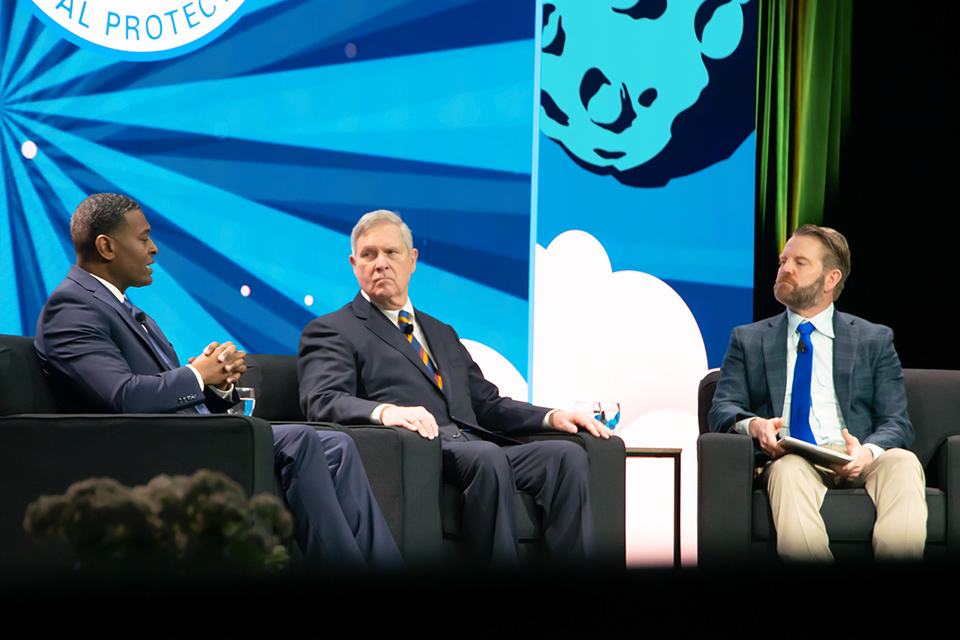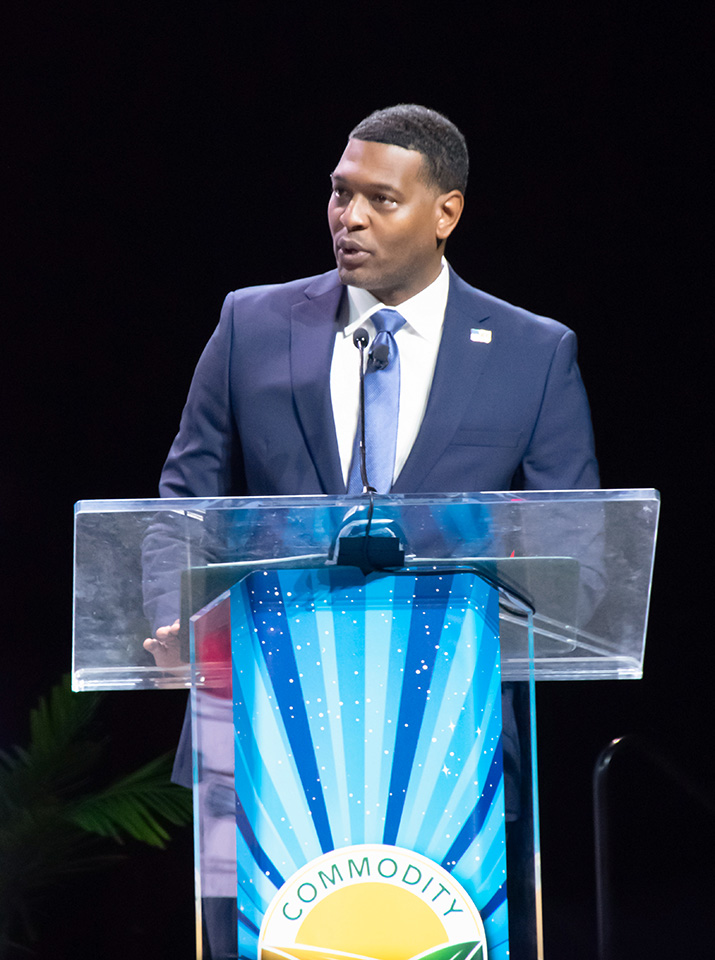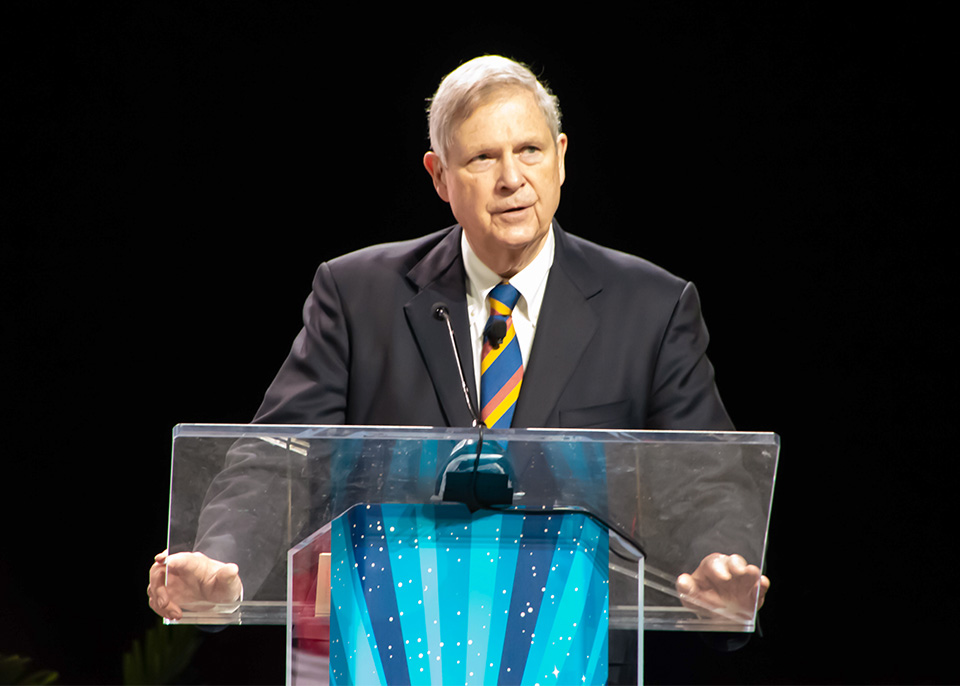
U.S. Secretary of Agriculture Tom Vilsack and EPA Administrator Michael Regan discuss current trends and issues impacting U.S. soybean prices during Commodity Classic. (Photo: Iowa Soybean Association / Bethany Baratta)
Biofuels, trade, climate smart ag dominate USDA, EPA joint appearance at Commodity Classic
March 1, 2024 | Aaron Putze, APR
A record crowd of more than 11,000 agricultural leaders gathered in Houston for Commodity Classic welcomed U.S. Ag Secretary Tom Vilsack and U.S. Environmental Protection Agency (EPA) Administrator Michael Regan to the general session stage earlier today.
Their joint appearance, a first at Commodity Classic, came just one day after Chevron Renewable Energy Group announced the indefinite idling of its biodiesel plant located in Ralston, Iowa, and another in Wisconsin. The Ames-based company cited poor business conditions caused by EPA’s lackluster biodiesel blend requirements set last year and enforced through 2025.
With that news top of mind, and soybean prices slumping and domestic and global supplies growing, both administrators focused intently on the issue of biofuels and trade.
SAF tax credits
Vilsack said the administration was not ready to announce guidance on Sustainable Aviation Fuel and tax credits for 2022-2024 and 2025 and beyond.
The much-anticipated news will wait, said Vilsack, as he commits to “measuring twice and cutting once” before making such an announcement.
“We want to make sure the latest and best information is included while formulating the guidance,” he said. “Making sure the GREET model is included in the process, which wasn’t at the start.”
Vilsack said he wants to ensure a wide variety of agricultural feedstocks could qualify for the SAF tax credits, particularly those produced using climate smart practices that farmers are already using in the field.
“Until several months ago, there wasn’t consensus on the modeling to use to make the calculations,” he added. “That takes some time and effort. Now we’re in the process of taking the next steps, which should take a matter of weeks.
“You also must verify that you’re doing what you say you’re doing. It’s complicated but we’re working through it. We’ll get there.”
While the models’ rollout was delayed, inclusion of cover crops and tillage would be good for soybean famers as higher adoption of climate smart production practices is one of the only ways to buy down the carbon intensity score of soybean production.”
Vilsack said the administration remains on track to achieve its goal of producing 3 billion gallons of SAF by 2030.
Renewable Fuels Standard

Regan, who was raised in rural eastern North Carolina, said the Renewable Fuels Standard is on a trajectory of growth and regulatory certainly.
“EPA is committed to getting the RFS “back on track and growing,” he said. “I’m proud that we’ve approved the largest renewable fuels obligations and for three years – 2023-2025.
“This diversifies our energy supply, reduces greenhouse gas emissions and improves national security.
“We’re also approaching the RFS and volume obligations in a way that’s legally defensible and scientifically sound,” he added.
EPA Office of Ag and Rural Affairs
Regan announced the EPA’s establishment of an Office of Ag and Rural Affairs to ensure the voices of farmers are heard and understood.
“We want farmers and ag stakeholders to have a seat at the table for generations to come,” he said.
“The office will create a central focal point to hear what USDA is saying and resolve differences and then push that information throughout all of EPA.”
USDA to host trilateral trade talks
Vilsack said he will host a trilateral meeting with the ag administrators of Mexico and Canada later this year in Colorado.
Issues on the table include Mexico’s stance on biotechnology and opening Canada’s market for U.S. dairy farmers. It will also include enforcing trade agreements and reducing trade barriers to agricultural products produced by farmers in the three countries.
Farm bill
“We’ll eventually get a farm bill, but we need a budget first,” said Vilsack.
It will be necessary, he added, for policy members to be creative.
“The need is great, but resources are limited. Therefore, it’s necessary to use every creative possibility. This includes using the Commodity Credit Corporation as it was intended to give policy makers flexibility to meet the many needs to modernizing the farm bill.”
Rural struggles
Vilsack said biofuels production increases revenue to farmers by nearly $19 billion annually. Yet farmers are struggling due to low commodity prices and high input costs.
“We’ve seen bumper crops and stresses in the Black Sea area. We have surplus crops, greater competition including South America. But what we may not fully appreciate is our capacity to get products to the global market,” he said.
Over the course of the past few years – while Brazil and South America improved – Vilsack says America’s logistical advantage has waned.
As a result, the administration has “doubled down” on the bipartisan infrastructure bill to address this concern.

Foreign land ownership
While China’s ownership of U.S. farmland is less than one tenth of one percent, Vilsack acknowledged concerns about the location of those land purchases.
China, he cautioned, is paying attention to the concerns and efforts to limit such purchases.
“We must know who is purchasing our land and where and when,” he said. “We must also diversify our reliance on the Chinese market by looking to southeast Asia and elsewhere.”
Vilsack said this includes investing resources in ag marketing where there have been few increases over time.
“Foreign market development work will be helped by resources from the Commodity Credit Corporation to focus on lower-level markets, have more people, promotions and presence in those markets, and to help tout the stability, safety and quality of what we raise in this country,” he said.
“Boosting exports also requires relationships and we are working to sustain important ones like that with China and other food insecure nations.”
“Many countries are depending on others for food and we’re ready to do our part in providing that,” said Vilsack, who previously served as the 40th governor of Iowa.
Inputs and Climate Smart Ag
Vilsack said the USDA has made considerable efforts to increase domestic production of fertilizer. This includes funding 40 projects in 25 states to produce fertilizer and to help farmers use fertilizer more efficiently.
Vilsack said he’s also encouraged about the uptake in climate smart agricultural practices and the allocation of federal resources to help farmers adopt practices and receive a premium for what they grow.
Putze serves as the ISA Chief Officer of Brand Management and Engagement. Contact him at aputze@iasoybeans.com
Back